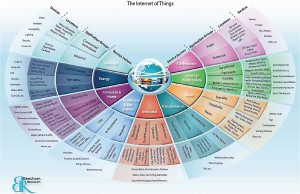
Berto Jongman: Internet of Things Changing the World — But Still No True Cost Self-Knowledge
Advanced Cyber/IOHow the Internet of everything will change the world
From the Internet of Things (IoT), where we are today, we are just beginning to enter a new realm: the Internet of Everything (IoE), where things will gain context awareness, increased processing power, and greater sensing abilities, says Cisco in their blog.
Add people and information into the mix and you get a network of networks where billions or even trillions of connections create unprecedented opportunities and give things that were silent a voice.
Cisco says their IoE as bringing together people, process, data, and things to make networked connections more relevant and valuable than ever before — turning information into actions that create new capabilities, richer experiences, and unprecedented economic opportunity for businesses, individuals, and countries.
Phi Beta Iota: Until true cost information is available for each “thing” or process or service, the network will not be intelligence and will not have integrity in the holistic sense. At the same time, absent a commitment to open standards, open spectrum, open everything, the “things” will not inter-relate as efficiently as possible.
Review: Making Friends Among the Taliban
6 Star Top 10%, Civil Affairs, Consciousness & Social IQ, Culture, Research, Diplomacy, Humanitarian Assistance, Peace, Poverty, & Middle Class, Philosophy, Religion & Politics of Religion, Stabilization & Reconstruction, Values, Ethics, Sustainable Evolution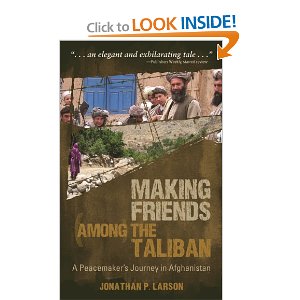
Jonathan P. Larson
5.0 out of 5 stars 6 Star Eye Opener, Should be Mandatory Reading for War Colleges, Diplomats, and White SOF,November 9, 2012
I received this book as a gift. It is a bracing book and although short, at 130 pages, it merits slow and deliberate consideration. I got goose-bumps at multiple points and put the book down reflecting on how sad it is that our foreign policy and our military occupations are not better informed about the information peacekeeping (a term I coined in the 1990's) possibilities of low-cost humans who speak the language and understand the nuances of conflict at the individual level.
This book is in every possible way, the absolute counterpart, contrast, and nay-sayer to the CIA-managed drone program that kills indiscriminately, at great expense, from which we will reap a continuing harvest of hatred, fear, and enduring mistrust.
Although I have read other books, and list them with Amazon links below, that offer similar insights, this is a first-person story with specifics that I consider so provocative and so valuable that I recommend it as assigned reading for every Special Operations A Team member, for every Special Operations schoolhouse, for every War College where we fail to teach White SOF as an alternative, and for every diplomat and international development employee, both at entry level and mid-career. I would go so far as to suggest that a week could usefully be spent by every conference group and foreign affairs class, on this book and the others listed below.
Clay Shirky: The Real Revolution is Openness
Culture, Education, Knowledge
The Real Revolution Is Openness, Clay Shirky Tells Tech Leaders
Wired Campus, November 7, 2012, 9:29 pm
By Marc Parry
Denver — Clay Shirky is one of the country’s most prominent Internet thinkers—“a spiritual guide to the wired set,” as The Chronicle Review put it in a 2010 profile of him. In his latest book, Cognitive Surplus,the New York University professor argues that a flowering of creative production will arise as the Internet turns people “from consumers to collaborators.”
On Wednesday, Mr. Shirky took that message to a group of higher-education-technology leaders who have been buffeted by a rapidly evolving ed-tech landscape. Mr. Shirky, in a keynote speech kicking off this year’s Educause conference, explored how technology was changing everything, from research to publishing to studying. (The talk starts about 20 minutes into this link.)
Continue reading “Clay Shirky: The Real Revolution is Openness”
Yoda: Research Fraud Has Exploded in Past Decade — Pattern of Fraud in Education, Intelligence, & Research
Academia, Commerce, Corruption, IO Impotency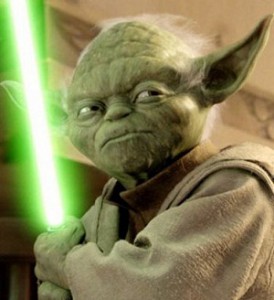
Sad, this is.
Research fraud exploded over the last decade
And retractions don't always mention when data's fraudulent (43% of the time, in fact).
A number of studies have spotted a worrisome trend: although the number of scientific journals and articles published is increasing each year, the rate of papers being retracted as invalid is increasing even faster. Some of these are being retracted due to obvious ethical lapses—fraudulent data or plagiarism—but some past studies have suggested errors and technical problems were the cause of the majority of problems. (…) The authors find that, since 1975, the rate of retracted articles as a percent of total publications has increased nearly tenfold. Duplicate publications and plagiarism, which didn't use to be a significant problem, have boomed since 2005. And while retractions due to errors have increased, those due to fraud have increased much faster.
. . . . . . . .
Patterns of deceit
When it comes to fraud, the traditional research powers are leading the way. The US has the largest number of cases, followed by Germany and Japan. But things like plagiarism and duplicating publications are quite different, with China being a major player, and India having a large presence. These sorts of copying problems are rare in high-profile journals like Nature and Science. Instead, there was a strong correlation between the incidence of fraud and the prominence of the journal, as measured by its impact factor.
Robert Steele: How Obama’s Team Melded Big Data to Raise Money & Win Votes, Defeating the “Nine Ways” and “Twelve Amigos”
Knowledge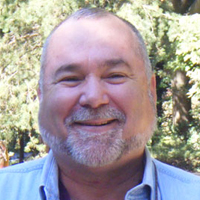
Click on Image for Personal Web Page
TIME has provided an utterly spectacular story on how the Obama team melded big data. As I finished the article, I could not help but wonder how much more useful the secret intelligence world would be, to so many more people, if it could do this for the rest of the world — with the $75 billion a year it spends — what the Obama team was able to do for a fraction of that price in the USA alone — as Stephen Cambone called for in 2000, neighborhood and household level granularity. This is what I told NSA in Las Vegas in 2002; this is what I put into a US Army monograph and a book in 2002. An Open Source Agency (OSA) as recommended by the 9/11 Commission, but under diplomatic or commercial auspices, remains the needed foundation for making intelligence (decision-support) not just relevant, but compellingly necessary to policy, acquisition, and operations.
In passing, this story helps us understand that Karl Rove did not do so badly — handicapped as he was by a party bent on self-destruction (or they would have nominated Ron Paul and an Independent or Libertarian Vice President) — the “nine ways” with “twelve amigos” came vastly closer than anyone had a right to expect.
Inside the Secret World of the Data Crunchers Who Helped Obama Win
TIME, 7 November 2012

In late spring, the backroom number crunchers who powered Barack Obama’s campaign to victory noticed that George Clooney had an almost gravitational tug on West Coast females ages 40 to 49. The women were far and away the single demographic group most likely to hand over cash, for a chance to dine in Hollywood with Clooney — and Obama.
So as they did with all the other data collected, stored and analyzed in the two-year drive for re-election, Obama’s top campaign aides decided to put this insight to use. They sought out an East Coast celebrity who had similar appeal among the same demographic, aiming to replicate the millions of dollars produced by the Clooney contest. “We were blessed with an overflowing menu of options, but we chose Sarah Jessica Parker,” explains a senior campaign adviser. And so the next Dinner with Barack contest was born: a chance to eat at Parker’s West Village brownstone.
. . . . . . . . .
How to Raise $1 Billion
John Robb: Resilience from Natural Gas Generators Plus Rain Capture Systems & Water Storage Bladders
Resilience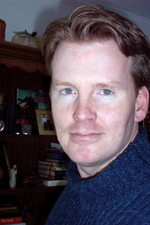
How to Avoid Fragility and Failure
By John Robb
Sandy knocked out power for 8.5 million people, mostly in New York and New Jersey. Wow. What's worse?
A week later, nearly a million people were still without power.
Now, a Nor'easter — a freezing cold version of a tropical storm that plagues New England during the Winter — just dropped nearly a record amount of snow on these same people.
NOTE: Again. Any time you hear “record-breaking” in relation to Finance and Weather, it usually isn't good news. When you hear it all the time, like we have recently, it's usually a sign that something is very wrong.
That's scary.
Of course, it doesn't have to be this difficult. A home and community that is resilient can bounce back from a regional disaster like this in seconds, if not hours. For example, my home and the homes of other people reading this letter right now didn't suffer an outage when the power went down. We produced our own power. Enough for us to serve as islands of resilience for our neighbors that didn't have this capability. To help them stay warm, recharge cell phones, take a hot shower, etc….
How?

